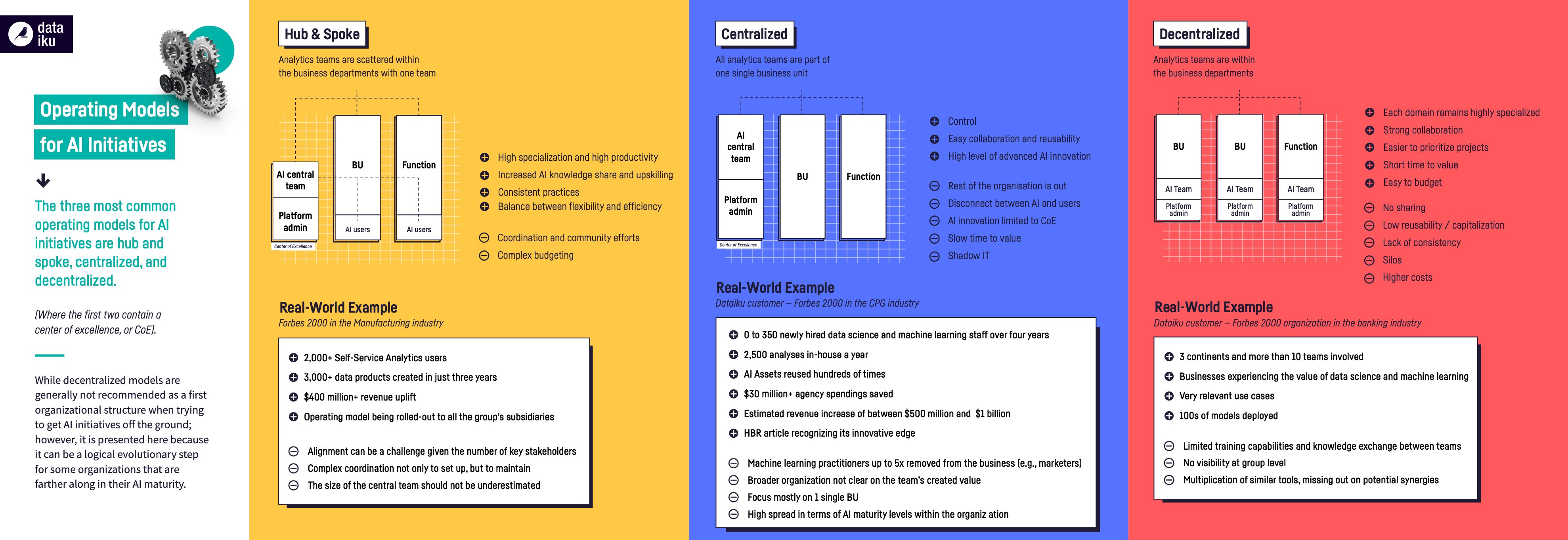The concept of AI in the enterprise has been around for a bit now, and the way different organizations have handled the implementation of data structures and management, as well as new evolutions in AI technology itself, varies greatly. Whether organizations are just now jumping into the game, or if they have benched their programs after finding themselves lost and confused in devising a strategy, many could benefit from studying an application approach such as NXP’s.
NXP — one of the world’s leading semiconductor companies providing the innovative technologies running households and businesses worldwide — has managed to build a data organization that both performs and, critically, elevates the individual. Here’s a look at how.
A Model Model
Breaking up a centralized versus decentralized dichotomy, NXP has designed a model that they refer to as their Hub & Spoke Model. This model expands the reach of the AI applications by organizing the delivery of data analytics alongside empowerment through tools, best practices, governance, and oversight.
So, for this hub and spoke model, do you go with a top-down or bottom-up approach? Well, at NXP, the answer isn’t black and white. Instead, NXP chooses to apply pressure in both directions — building opportunity and bridging the gap.
“Build a groundswell of opportunity and enthusiasm within the organization. Ultimately, it's the leadership that has to establish the structure. But we targeted both the executives, the suite and the individuals in NXP to really maximize our opportunity to grow and mature.” - Lance Lambert
Executive awareness of the overarching goals coupled with champions at various levels and across all teams makes certain that the cause is being driven down and infiltrated throughout the organization. NXP hosts multiple Centers of Excellence (COEs). These COEs foster a sense of community so that even on a global scale, they sustain collaboration. People facing similar challenges can amalgamate for problem-solving and join forces to be stewards of the surfacing innovations.
A piece of advice that Lance Lambert offers to those following down the path of AI application is to apply more pressure at the top sooner, establishing evangelists at the executive level right away in order to get a full grasp early on of all that is possible for the organization through data analytics.
Click to enlarge for the full version:
Picking Partners
NXP insists on approaching vendor partners as strategic partners. What does this mean? It means that instead of looking only for immediate fixes for today’s problems, NXP looks for long-term alignment. Carefully vetting vendors means that only those that fit into the future vision for the organization and align easily with long-term business strategies are chosen. One aspect of this is ensuring that the selected vendors have a similarly progressive outlook on technology applications. Dataiku and NXP as organizations both look to stay on the frontier of technology without sacrificing reliability or responsibility.
“We look at them as collaborators in our strategic initiative, and that helps us, I think, both stay ahead of what's emerging within the industry and ensuring that we have the latest capabilities that are meaningful to us available to our communities and our individuals.”- Lance Lambert
The vendors possessing these qualities give you a competitive edge that their counterparts lacking strategic alignment and technological progressivity cannot provide.
Let’s Talk Talent
A new opportunity for enterprise applications within manufacturing is shaping via the emergence of advanced analytic capabilities, and, contrary to the myths, AI is not dehumanizing organizations. In fact, with the implementation of AI, there is a slew of opportunities for people to involve these applications in their existing business processes, increasing effectiveness and revving up project completion pace. It goes without saying that, with these opportunities, there exists a push to move quickly, accessing talent that has the ability to take full advantage of this burgeoning technical arena. The conversation is becoming more and more about how to find talent already championing these skillsets or ways to develop these skillsets internally.
NXP provides employees with an online learning platform referred to as BI University. No matter their existing expertise level, anyone can develop their data and analytics skillsets. In addition to BI University, the Citizen Data Scientist Program is an annual program that allows individuals with foundational data analytics, competencies, and skillsets to elevate their expertise with tools such as Dataiku.
“There are 9,000 people within our company who are interacting with our data and analytics program in some form or another, collecting data for analysis, presenting and visualizing data for decision makers.” - Lance Lambert
Lambert even suggests that the whole talent process should begin before individuals are within the organization. NXP places attention on supporting emerging skillsets starting at the university level and hosts robust internship programs.
Additionally, a strong focus is placed on cross-departmental communication. Collaboration is specifically rewarding with the human resources department. Aim to craft an acquisition process that creates a talent pipeline that serves the emerging needs of the organization, thus enabling higher retention as well as better career path development for the recruited individuals.
To Externalize or Not
NXP internalizes everything directly linked to intellectual property, but they do not shy away from getting support for their internal teams through outside sources when it is needed.
External support helps internal teams by ramping up resources for specific projects. Providing the option for support in both specialized and standard skillsets, the overall efficiency of operations is boosted. Valuable project time is no longer lost to the catch-up learning limbo of teams that are at varying levels of maturity.
Core Work
At NXP, the fundamentals are the principles. Lambert stresses that business value should be the X-marks-the-spot for an organization’s innovation journey in lieu of chasing after each and every shiny new object. Focusing on sustainability and accessibility builds a strong foundation for company goals. Understanding how the applications will support core business functions and placing an emphasis on good quality data will translate into real value for the organization.





